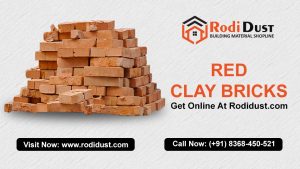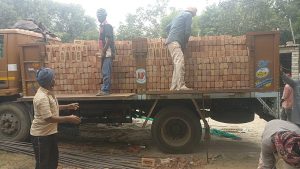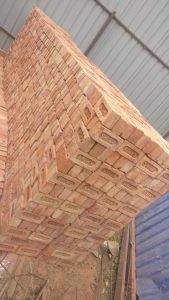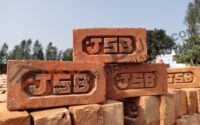Bricks a Preferred Building Material
What makes Fired Clay Bricks a preferred building material?
A brick is building material used to make walls, pavements and other elements in masonry construction. Traditionally, the term brick referred to a unit composed of clay, but it is now used to denote rectangular units made of clay-bearing soil, sand, and lime, or concrete materials. Bricks can be joined together using mortar, adhesives or by interlocking them.

Properties of Bricks:
- Physical Properties:
- Shape: The standard shape is rectangular. It has sharp edges and the surface is even.
- Size: In India the standard size of the brick is 19cm X 9cm X 9cm and it varies from country to country.
- Color: The most common color of building bricks falls under the class RED. It may vary from deep red to light red. Very dark shades of red indicate over burnt bricks whereas yellow color is often indicative of under-burning.
- Density: The density of bricks or weight per unit volume depends mostly on the type of clay used and the method of brick molding (soft-mud, Stiff-mud, hard-pressed etc.). In the case of standard bricks, density varies from 1600 kg/cubic meter to 1900 kg/cubic meter. A single brick (19 x 9 x 9 cm) will weigh between 3.2 to 3.5 kg depending upon its density.
- Mechanical Properties:
1. Compressive Strength of Bricks: It is the most important property as these are used in load bearing walls. The compressive strength of a brick depends on the composition of the clay and degree of burning. It may vary from 35 kg/cm2 to more than 200 kg/cm2 in India.
2. Flexural Strength of Brick: Bricks should be able to take the transverse loads. Flexural strength should not be less than 10kg/cm2 for common building.
- Insulation Properties:
Bricks should also provide insulation against heat, cold & noise. It majorly depends upon density and porosity. If the bricks are heavy and dense then they have bad insulation.
- Durability Properties:
By durability of bricks, means the maximum time for which they remain unaltered and strong when used in construction. Some Factors affecting durability are:
- Absorption Value: Absorption value or simply absorption, is the quantity of water absorbed by the (brick) sample. The ordinary bricks should not have absorption value greater than 25% and in first class bricks the absorption value should not be more than 20%. Higher porosity leads to strength reduction and more water penetrating means more chances of dampness.
- Frost Resistance: When water freezes it expands 10% and exerts more pressure. Bricks should be protected from rain as these are very porous and in cold climates it can result in frost action and thus decay.
- Efflorescence: As bricks are porous so in rains the water enters the pores and when the evaporation process starts the salts which were already present in the clay comes out with the water and forms a white or gray patches. Salts are sulfates of calcium, magnesium, sodium and potassium. Clay should always be tested for chemical composition before being used for brick manufacturing.



Qualities of good Clay Brick:
- It should be well brunt, with uniform shape, size, colour and free from cracks.
- The colour of brick generally deep red & copper with uniform texture
- Should be free from voids and should be homogenous when broken.
- It should be hard and give metallic ringing sound when struck with each other.
- It should not break while striking with each other or dropped from a height of about 1.2 to 1.5 mtr on to the ground.
- When soaked in water for 24 hours the brick should not show deposits of white salts on surface when dried up.
Tests & its Procedure for Bricks:
1. Absorption Test:
1. Dry the specimen in a drying oven at a temperature of 1100 C to 1150 C for 24 hrs.
2. Remove the Bricks from the oven and cool them to room temperature and obtain it’s dry weight M1 (kg).
3. The dried specimen is immersed completely in clean water at a room temperature of 27 ± 20 C for 24 hours.
4. Remove the specimen and wipe out any traces of water with a damp cloth and weighing the specimen within three minutes after its removal from water. Let its weight be M2 (kg).
5. W = ((M2-M1)/M1) X 100
6. Average result is reported.
2. Compressive Strength of Brick:
1. Take five bricks samples and immerse them in water for 24 hours at room temperature.
2. After 24 hours, take them out, allow them to drain and then clean the surplus water.
3. Now, fill their frogs (and any other voids) by a layer of standard 1:1 mortar (1 part cement and 1 part sand). Store these bricks under damp sacks for 24 hours (to allow setting of mortar).
4. Place the bricks in water for seven days. (This is to allow the mortar to harden).
5. Take the bricks out of the water, allow the water to drain and remove the surplus water. When surface dry, each brick is tested for compressive strength individually.
6. Place the brick flat-wise, with frog end facing upward, between two plywood sheets.
7. Brick so adjusted between the plywood sheets is placed on the bed of compressive strength of bricks testing machine and load is applied axially and at a uniform rate of 140 kg/cm2/minute. (This is very important).
8. Note the load at which the brick fails (gets broken). This load (P) is divided by cross-sectional area (A) of the brick gives the compressive strength (Co). Co=P/A
9. Average is taken as compressive strength.
3. Hardness Test of Brick:
This test is done to know the hardness of bricks. In this test, scratches are made on the surface of the brick by a hard thing. If it does not leave any impression on the brick surface then it will be considered as good quality bricks.
4. Presence of Soluble Salts (Efflorescence Test):
The soluble salts, if present in cause efflorescence in brick work. For finding out the presence of soluble salts in a brick, it is immersed in water for 24 hours. It is then taken out and allowed to dry in shade. The absence of grey or white deposits on indicates absence of soluble salts.
If the white deposits cover about 10 per cent surface, the efflorescence is said to be slight and it is considered as moderate, when the white deposits cover about 50 per cent of surface. If grey or white deposits are found on more than 50 per cent of surface, the efflorescence becomes heavy and it is treated as serious.
5. Shape, Size & Color Test of Bricks:
In this test randomly collected 20 bricks are staked along lengthwise, width wise and height wise and then those are measured to know the variation of sizes as per standard.
6. Soundness Test of Bricks:
In this test, the two bricks are taken and they are struck with each other. The bricks should not break and a clear metallic ringing sound should be produced.
7. Structure Test of Bricks:
In this test, a brick is broken or a broken brick is collected and closely observed. If there are any flows, cracks or holes present on that broken face then that isn’t good quality brick. It should be homogenous and compact.
Advantages of Clay Bricks:
- Economical.
- Hard & Durable.
- Low maintenance cost.
- Fire resistance is good.
- Demolition of brick structures are easy.
- Different orientations & sizes provide surface texture.
Disadvantages of clay bricks:
- Less tensile strength.
- Time consuming construction process.
- These are porous so they absorb water and it causes florescence when exposed to air.
- Color of low quality bricks changes over time when exposed to sun.
Applications of Clay Bricks:
- Buildings
- Foundation
- Arches
- Pavements
- Brick Flooring
- For Architectural Purposes (Façade work etc.)
What are your views on this blog ? please share on our facebook page
https://www.facebook.com/rodidust
For more enquires please feel free to contact us :





